跨文化交际与翻译
跨文化交际
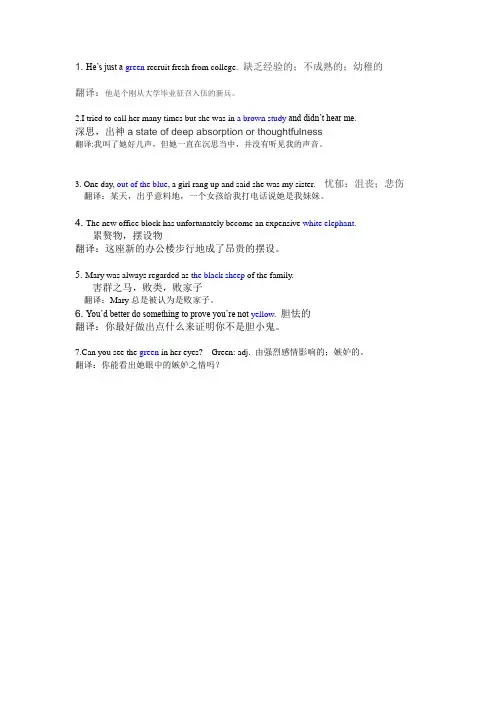
1. He’s just a green recruit fresh from college.缺乏经验的;不成熟的;幼稚的
翻译:他是个刚从大学毕业征召入伍的新兵。
2.I tried to call her many times but she was in a brown study and didn’t hear me.
深思,出神a state of deep absorption or thoughtfulness
翻译:我叫了她好几声,但她一直在沉思当中,并没有听见我的声音。
3. One day, out of the blue, a girl rang up and said she was my sister. 忧郁;沮丧;悲伤翻译:某天,出乎意料地,一个女孩给我打电话说她是我妹妹。
4. The new office block has unfortunately become an expensive white elephant.
累赘物,摆设物
翻译:这座新的办公楼步行地成了昂贵的摆设。
5.Mary was always regarded as t he black sheep of the family.
害群之马,败类,败家子
翻译:Mary总是被认为是败家子。
6. You’d better do something to prove you’re not yellow. 胆怯的
翻译:你最好做出点什么来证明你不是胆小鬼。
7.Can you see the green in her eyes? Green: adj. 由强烈感情影响的;嫉妒的。
翻译:你能看出她眼中的嫉妒之情吗?。
翻译与跨文化交际的关系研究
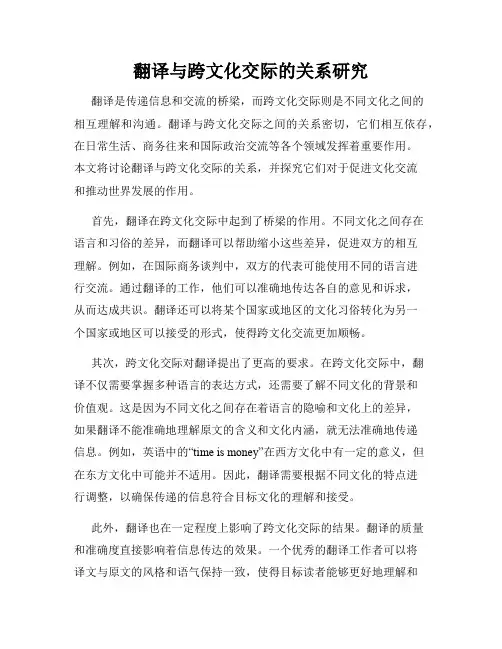
翻译与跨文化交际的关系研究翻译是传递信息和交流的桥梁,而跨文化交际则是不同文化之间的相互理解和沟通。
翻译与跨文化交际之间的关系密切,它们相互依存,在日常生活、商务往来和国际政治交流等各个领域发挥着重要作用。
本文将讨论翻译与跨文化交际的关系,并探究它们对于促进文化交流和推动世界发展的作用。
首先,翻译在跨文化交际中起到了桥梁的作用。
不同文化之间存在语言和习俗的差异,而翻译可以帮助缩小这些差异,促进双方的相互理解。
例如,在国际商务谈判中,双方的代表可能使用不同的语言进行交流。
通过翻译的工作,他们可以准确地传达各自的意见和诉求,从而达成共识。
翻译还可以将某个国家或地区的文化习俗转化为另一个国家或地区可以接受的形式,使得跨文化交流更加顺畅。
其次,跨文化交际对翻译提出了更高的要求。
在跨文化交际中,翻译不仅需要掌握多种语言的表达方式,还需要了解不同文化的背景和价值观。
这是因为不同文化之间存在着语言的隐喻和文化上的差异,如果翻译不能准确地理解原文的含义和文化内涵,就无法准确地传递信息。
例如,英语中的“time is money”在西方文化中有一定的意义,但在东方文化中可能并不适用。
因此,翻译需要根据不同文化的特点进行调整,以确保传递的信息符合目标文化的理解和接受。
此外,翻译也在一定程度上影响了跨文化交际的结果。
翻译的质量和准确度直接影响着信息传达的效果。
一个优秀的翻译工作者可以将译文与原文的风格和语气保持一致,使得目标读者能够更好地理解和接受信息。
然而,一个翻译错误或不当的翻译可能导致误会和误解,潜在地破坏了跨文化交际的效果。
因此,在跨文化交际中,翻译的质量至关重要,翻译工作者需要具备良好的语言和文化素养,以确保信息的准确性和可靠性。
最后,翻译与跨文化交际的关系也受到现代科技的影响。
随着全球化的加深和互联网的普及,翻译工作不再局限于书面文字的互译,口译和实时翻译也变得越来越重要。
例如,语音翻译设备和在线翻译软件可以实时将不同语言的口头表达转化为文字,从而实现不同语言之间的实时交流。
新编跨文化交际【warm up】 原文及翻译
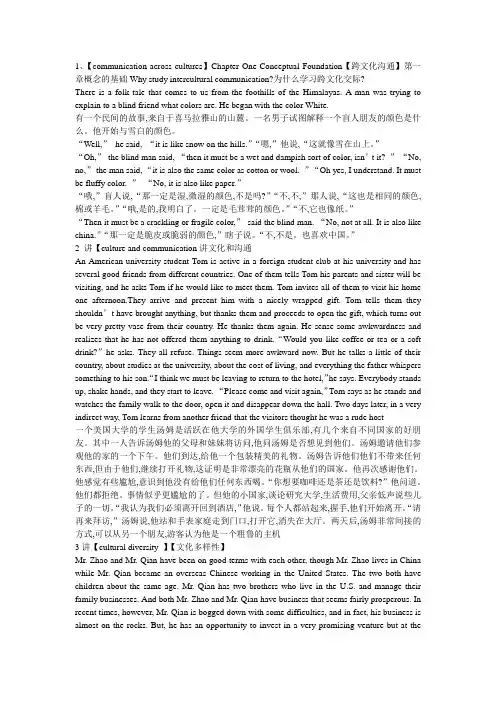
1、【communication across cultures】Chapter One Conceptual Foundation【跨文化沟通】第一章概念的基础Why study intercultural communication?为什么学习跨文化交际?There is a folk tale that comes to us from the foothills of the Himalayas. A man was trying to explain to a blind friend what colors are. He began with the color White.有一个民间的故事,来自于喜马拉雅山的山麓。
一名男子试图解释一个盲人朋友的颜色是什么。
他开始与雪白的颜色。
“Well,”he said, “it is like snow on the hills.”“嗯,”他说,“这就像雪在山上。
”“Oh,”the blind man said, “then it must be a wet and dampish sort of color, isn’t it? ”“No, no,”the man said, “it is also the same color as cotton or wool. ”“Oh yes, I understand. It must be fluffy color. ”“No, it is also like paper.”“哦,”盲人说,“那一定是湿,微湿的颜色,不是吗?”“不,不,”那人说,“这也是相同的颜色,棉或羊毛。
”“哦,是的,我明白了。
一定是毛茸茸的颜色。
”“不,它也像纸。
”“Then it must be a crackling or fragile color,”said the blind man. “No, not at all. It is also like china.”“那一定是脆皮或脆弱的颜色,”瞎子说。
跨文化交际unit课后translation中英对照
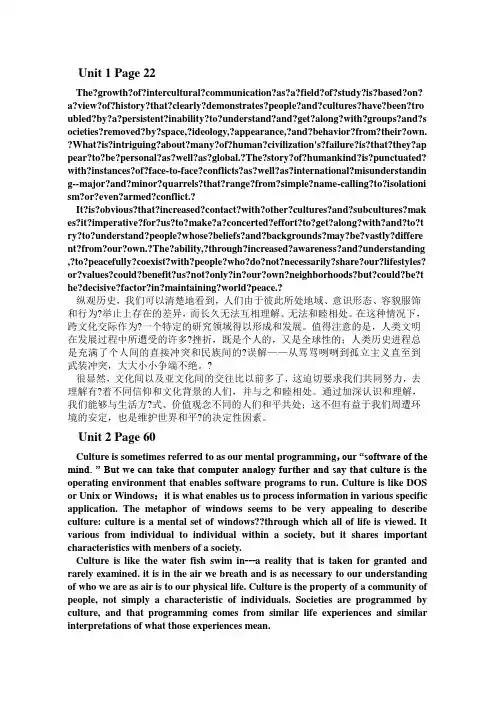
Unit 1 Page 22The?growth?of?intercultural?communication?as?a?field?of?study?is?based?on? a?view?of?history?that?clearly?demonstrates?people?and?cultures?have?been?tro ubled?by?a?persistent?inability?to?understand?and?get?along?with?groups?and?s ocieties?removed?by?space,?ideology,?appearance,?and?behavior?from?their?own. ?What?is?intriguing?about?many?of?human?civilization's?failure?is?that?they?ap pear?to?be?personal?as?well?as?global.?The?story?of?humankind?is?punctuated? with?instances?of?face-to-face?conflicts?as?well?as?international?misunderstandin g--major?and?minor?quarrels?that?range?from?simple?name-calling?to?isolationi sm?or?even?armed?conflict.?It?is?obvious?that?increased?contact?with?other?cultures?and?subcultures?mak es?it?imperative?for?us?to?make?a?concerted?effort?to?get?along?with?and?to?t ry?to?understand?people?whose?beliefs?and?backgrounds?may?be?vastly?differe nt?from?our?own.?The?ability,?through?increased?awareness?and?understanding ,?to?peacefully?coexist?with?people?who?do?not?necessarily?share?our?lifestyles? or?values?could?benefit?us?not?only?in?our?own?neighborhoods?but?could?be?t he?decisive?factor?in?maintaining?world?peace.?纵观历史,我们可以清楚地看到,人们由于彼此所处地域、意识形态、容貌服饰和行为?举止上存在的差异,而长久无法互相理解、无法和睦相处。
跨文化交际与翻译-
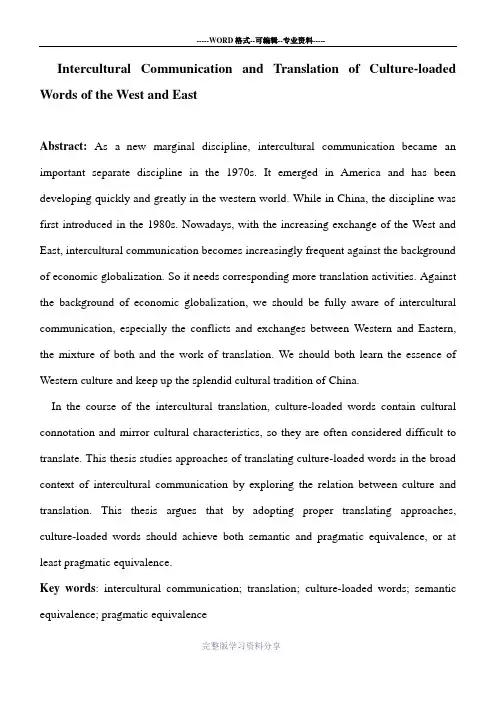
Intercultural Communication and Translation of Culture-loaded Words of the West and EastAbstract:As a new marginal discipline, intercultural communication became an important separate discipline in the 1970s. It emerged in America and has been developing quickly and greatly in the western world. While in China, the discipline was first introduced in the 1980s. Nowadays, with the increasing exchange of the West and East, intercultural communication becomes increasingly frequent against the background of economic globalization. So it needs corresponding more translation activities. Against the background of economic globalization, we should be fully aware of intercultural communication, especially the conflicts and exchanges between Western and Eastern, the mixture of both and the work of translation. We should both learn the essence of Western culture and keep up the splendid cultural tradition of China.In the course of the intercultural translation, culture-loaded words contain cultural connotation and mirror cultural characteristics, so they are often considered difficult to translate. This thesis studies approaches of translating culture-loaded words in the broad context of intercultural communication by exploring the relation between culture and translation. This thesis argues that by adopting proper translating approaches, culture-loaded words should achieve both semantic and pragmatic equivalence, or at least pragmatic equivalence.Key words: intercultural communication; translation; culture-loaded words; semantic equivalence; pragmatic equivalenceIntroductionIntercultural communication involves two different cultures, and different culture created a different national language. Culture plays an important role in specific semantic structure and model of language. The vocabulary is the accumulation of cultural information, and the cultural concepts and values of different nation at all levels of culture are "reflected in their vocabulary system, and then form the words with cultural connotation." [1]With special cultural connotation, cultural words are often difficult in cross-cultural communication translation, and even become an obstacle to transmission of information.Influence of culture on translationFrom the perspective of intercultural communication, one of the purposes is to establish the cultural equivalence between the source language and target language. In terms of the translation of cultural terms, the cultural equivalence mainly reflects in the semantic equivalence and pragmatic equivalence. Semantic equivalence is the basis of pragmatic equivalence. Thus, in many cases, equivalent translation is also mainly refers to the semantic equivalence.The author believes that the basic principles of cultural lexicon translation should be done to maximize the semantic and pragmatic equivalence. We should at least ensure the pragmatic equivalence if semantic equivalence can not be achieved. For instance, in Tianjin city of China, there is a century-old snack "Goubuli" steamed buns, and now many tourist cities in the country establish its branches, and the buns are also soldabroad. Its English translation "Dog Won't Leave" is far from its original Chinese name meaning. And there is no semantic equivalent at all, because the Chinese "dog ignore" have no contact with “the dog” and “leave”. However, from the perspective of pragmatic translation, “Dog Won't Leave” is a wonderful translation. Dogs won’t leave buns stands for it will not leave its host either. Undoubtedly, such translation has a strong attraction force for diners in English and America who love dogs like loving friends. Basically, the equivalence in pragmatic effects is achieved.As the source language and target language are different in language and culture, it is almost impossible to achieve totally equivalence in semantic and pragmatic aspect for the source language and target language symbols. Therefore, when translating cultural words, we only try to pursuit of semantic equivalence as far as possible under the premise of ensuring pragmatic equivalence. There are five commonly used methods when translating cultural words:First, shift translation. It refers to unchanged moving all or part of the source language to the target language. For instances, CD, VCD, DVD, DNA, ICU, and many computer terms which are translated into Chinese by the shift frequently appear on Chinese newspapers and magazines. Some expressions with Chinese characteristics like qigong (qigong), taijiquan (shadow boxing), jiaozi (dumplings), qipao (cheongsam), has moved in English and American newspapers.Second, transliteration. Some of the source language culture-specific images are "blank" or "vacant” in the target language. I n this case, we can transplant these unique to the target language using transliteration method. Transliteration is homophonic inChinese words or word combinations in English translation, and these words or word combinations are not meaningful ready-made words in Chinese. For instance: 秀(show), 酷(cool), 黑客(hacker), 艾滋病(AIDS), 色拉(salad), 可口可乐(Coca-cola) and so on.Third, literal translation. Literal translation refers to translation of the "corresponding" phrase and cultural information in the source language. This can preserve cultural identity of the source language as much as possible and broaden the cultural horizons of target language readers. However, it can not be applied mechanically, and it should not mislead the reader of the target language. For instance: olive branch (橄榄树), lonely as a cloud (像一朵孤云), 纸老虎(paper tiger),一国两制(one country with two systems), etc.Four, free translation. It focuses on the translation to convey the original meaning (interpretation), which lay down the language form and literal meaning of the source language. It expresses the cultural information of source language in the target language with cross-cultural "pragmatic equivalence. For instance: the Renaissance (文艺复兴); "辛亥革命"(the 1911 Revolution against Qing Dynasty), etc.Five, Replacement. It refers to the replacement of original words with some similar meaning but different concept meaning in the target language on the basis of keeping communication meaning of the original. That is to replace words with rich cultural connotation in the source language with corresponding word with same cultural connotation in the target language. Such as: to laugh off one's head (笑掉大牙); lead a dog's life (过着牛马不如的生活); 挥金如土(to spend money like water); 力大如牛(asstrong as a horse).ConclusionEnglish and Chinese are two different languages, and both reflect the cultural differences which form the barrier of communication. How to overcome obstacles and achieve cultural equivalence is a difficult problem to solve. Practice shows that in most cases we can find reasonable translation methods which can be accepted by readers in the target language. By means of the necessary modifications, we can at least achieve pragmatic equivalence. The important thing is that the translators should attach great importance to cultural factors in the source language, and consider issues from the purpose of intercultural communication.。
跨文化交际-其他要点翻译
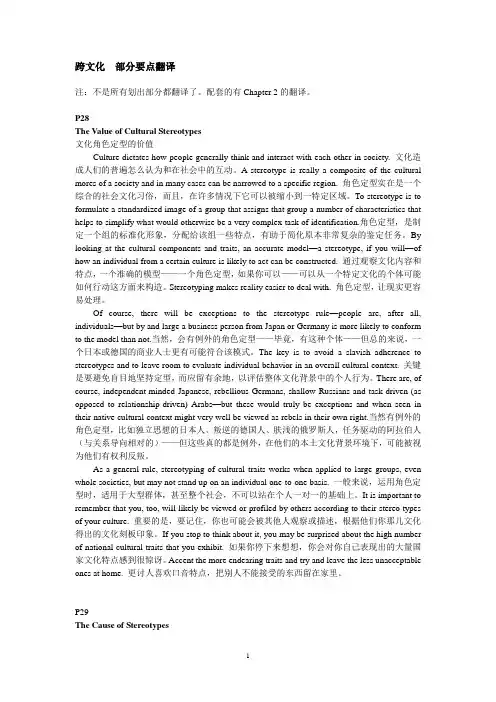
跨文化部分要点翻译注:不是所有划出部分都翻译了。
配套的有Chapter 2的翻译。
P28The Value of Cultural Stereotypes文化角色定型的价值Culture dictates how people generally think and interact with each other in society.文化造成人们的普遍怎么认为和在社会中的互动。
A stereotype is really a composite of the cultural mores of a society and in many cases can be narrowed to a specific region.角色定型实在是一个综合的社会文化习俗,而且,在许多情况下它可以被缩小到一特定区域。
To stereotype is to formulate a standardized image of a group that assigns that group a number of characteristics that helps to simplify what would otherwise be a very complex task of identification.角色定型,是制定一个组的标准化形象,分配给该组一些特点,有助于简化原本非常复杂的鉴定任务。
By looking at the cultural components and traits, an accurate model—a stereotype, if you will—of how an individual from a certain culture is likely to act can be constructed.通过观察文化内容和特点,一个准确的模型——一个角色定型,如果你可以——可以从一个特定文化的个体可能如何行动这方面来构造。
跨文化交际与翻译技巧
跨文化交际与翻译技巧在一个日益全球化的世界中,跨文化交际和翻译技巧成为了越来越重要的能力。
无论是跨国企业合作、国际会议交流还是旅行观光,我们都需要理解和尊重不同文化背景下的语言和社交规则。
本文将探讨跨文化交际和翻译技巧,并提供一些实用的建议。
一、了解文化差异跨文化交际的第一步是了解目标文化的差异。
不同的文化可能有着不同的价值观、信仰体系、社会习俗等等。
在希腊,拥抱是一种常见的问候方式,而在日本,鞠躬则是一种表示尊敬的方式。
对于这些差异的了解可以帮助我们适应和尊重他人的文化。
二、避免使用俚语和隐喻在跨文化交际中,使用俚语和隐喻容易产生误解。
这些表达方式在不同的文化中可能具有不同的含义,甚至可能引起冒犯。
因此,建议在交流中使用简明扼要、清晰简洁的语言,以减少沟通障碍。
三、注意非语言交际非语言交际在跨文化交际中起着重要的作用。
姿势、面部表情、眼神接触等可以传递出更多的信息。
然而,这些非语言信号在不同的文化中可能会有不同的解读。
举个例子,在中国,直视对方的眼睛被认为是尊重和诚实的表现,而在日本,这种行为可能被视为威胁或挑衅。
因此,我们需要注意并尊重对方的非语言交际方式。
四、掌握翻译技巧翻译是跨文化交际中必不可少的一部分。
为了准确传达信息,下面是一些翻译技巧:1. 理解上下文:在翻译时,要将句子放在更广泛的语境中来理解其意义。
这有助于避免误解和错误的翻译。
2. 注重语言的特点:不同语言之间存在着不同的语法、词汇和表达方式。
了解目标语言的特点可以帮助我们做出更准确、自然的翻译。
3. 确保准确性和一致性:翻译时要确保准确传达原文的意思,并保持整体翻译的一致性。
这需要仔细选择词汇和语法结构,以免导致歧义或混淆。
4. 不要直译:直译可能会导致意思不清或令人困惑。
在翻译时,要理解原文的意图,并找到最合适的方式来传达信息。
五、使用辅助工具在现代科技的帮助下,我们可以使用各种辅助工具来提升翻译的效率和准确性。
例如,在线词典和翻译软件可以帮助我们查找单词的释义和选择适当的翻译。
跨文化交际课文翻译
关于跨文化交流,跨文化市场才是第一的真正的首要的范本。
考虑到古罗马帝国的市民,他们是第一个诞生商店的地球文明。
商人们通过在商店的上面树立旗帜来展示他们商品货物的图片来解决跨文化市场的困扰。
这种做法不仅能为罗马帝国中未受过教育的市民服务还能帮助罗马商人们获得被他们用武力征服的殖民地的商业信息。
回顾过去,我们会发现两千多年前的亚里士多德曾明确说过:“有效劝服基本的信念仍可以把他应用到今天的买卖商品上然而在古代的雅典可能会引起一场大的争论”。
很明显的可以看出,交流是现代市场的根基。
毋庸置疑,全球化市场的时代已经到来。
每年超过4万件的商品货物进入国际市场,其中超过一半是来自美国。
这里面85%的商品都不合格。
通往国际化市场成功的道路是建立在失败的市场垃圾碎片和广泛的广告活动之上的。
他们中的大多数之所以会失败,是因为跨文化交流被曲解了。
在跨文化市场里,如果你想把低劣的语言举止降低到最小,那么就不假定任何事情。
几乎我们都听说过关于美国通用汽车公司,他们尽力想把他们的雪佛兰牌汽车销往拉美国家。
但是雪佛兰在说西班牙语的拉美国家按字面意思是不能行走。
当公司发现汽车买不出去的原因时,他们就把车重新命名,然后销往这些国家。
福特汽车公司,美国又一个汽车界的领头羊,也有类似的问题。
他们的pinto 牌汽车在当地也没有达到预期的销售,原因时他们的汽车其意思在当地为男性生殖器。
最终福特公司把所有的名牌汽车重新命名为corcel,其意思为骏马。
伊莱克斯,一个日用电器制造者,其在英国获得了很大的成功。
不幸的是,他们的广告招牌的意思在美国和英国大不相同。
在美国,suck的意思是多虱子的。
英国的牙膏生产商在法国制造出来了一种牙膏叫cue。
它被人们所耻笑。
因为它的名字使人想起了臭名昭著的色情杂志——Cue。
但是市场中的文化意识更多于细心的翻译。
每一文化都有其微妙之处,当然也有其鲜明的禁忌。
尽管大多数的人不能列出他们自己文化的规则,但是他们很明白什么时候这些禁忌被触碰了。
跨文化交际中英文化对比课文参考译文U1
第一单元语言:汉语与英语Section A 汉语Passage 1 中文的方方面面1汉语是汉藏语系的一个分支,由数百种地方语言组成,其中许多语言互不相通。
据估计,10多亿人的第一语言是某种形式的汉语作。
历史2古汉语是经证明最古老的汉语,是所有现代汉语变体的始祖。
从先秦到晋代都使用过古文。
中国最早的文字记载出现在3000多年前,最早的例子是商代末年甲骨上的占卜铭文。
在随后的周朝,青铜器铭文变得丰富起来。
周朝后半期文学繁荣发展,包括《论语》、《孟子》、《春秋》等经典著作。
这些作品都是文言文的典范。
3中古汉语是南北朝和隋唐宋时期使用的语言,可以分为以韵书《切韵》为标志的早期中古汉语,和以切韵系统的指南“韵表”为标志的晚期中古汉语。
中古汉语是恢复早期汉语发音的口传的起点。
4北宋灭亡后,在晋朝和元朝时期,中国北方出现了一种通用语(现在称为旧官话)。
明清时期的官员们使用基于普通话变体的“官话”来管理国家。
在明清时期的多半时间里,这种语言是以南京地区的方言为基础的,但与任何一种方言都不完全相同。
到1909年,即将灭亡的清朝将北京话定为“国语”5中华人民共和国继续推行共同的国语,于1956年正式确定了中国的标准语言。
普通话是现代汉语的标准形式,以北京语音系统为发音规范,以北方方言为方言基础,以白话文学语言为语法规范。
在中国,普通话现在被用于教育、媒体和正式场合。
汉语是联合国六种官方语言之一。
发音7 汉字不能可靠地指明其发音。
因此,对于那些不识汉字的人来说,将汉语音译成拉丁字母是很有用的。
拼音系统是在20世纪50年代由许多语言学家在早期汉语罗马化形式的基础上发展起来的。
1958年由中国政府出版,并多次修订。
国际标准化组织(ISO)于1982年将拼音作为一项国际标准,随后于1986年被联合国采用。
8声母和韵母构成拼音的基本要素。
普通话的每个音节都可以用一个声母后跟一个韵母拼写,或者在某些情况下只有一个韵母,但特殊音节er或后缀-r被视为音节的一部分时除外。
跨文化交际_Unit_2_参考翻译
Unit Two Task 11)A smooth sea never made a skillful mariner. 平静的大海决不能造就出熟练的水手。
/花盆里生长不出参天大树。
/温室里长不出栋梁之才。
2)He who would search for pearls must dive below.不入虎穴,焉得虎子。
/ 欲寻珍珠就要潜到水里。
/ 欲寻珍珠欲潜入水。
3)Living without an aim is like sailing without a compass. 生活没有目标如同航行没有罗盘。
/没有目标的生活如同没有罗盘的航行。
4)To have another fish to fry另有要事/ 另有事情得做5)The water that bears the boat is the same that swallows it up.水能载舟,亦能覆舟。
(The same knife cuts bread and fingers.)6)前人栽树,后人乘凉。
One sows and another reaps. / One man sows and another reaps. / One generation plants the trees in whose shade another generation rests. / The precedence planted, the later generations enjoy its cool.7)斩草不除根,逢春又发青。
If the grass is only cut, then the next spring it will revive. / Cut weeds and dig up the roots.8)种田不用问,深耕多上粪。
Planting has no better measures but ploughing deeply and fertilizing much more.9)生米煮成熟饭。
- 1、下载文档前请自行甄别文档内容的完整性,平台不提供额外的编辑、内容补充、找答案等附加服务。
- 2、"仅部分预览"的文档,不可在线预览部分如存在完整性等问题,可反馈申请退款(可完整预览的文档不适用该条件!)。
- 3、如文档侵犯您的权益,请联系客服反馈,我们会尽快为您处理(人工客服工作时间:9:00-18:30)。
Intercultural communication and translation Intercultural communication mainly refers to the communication between the native speakers and non-native speakers, as well as the communication between people who differ in any aspect of language or culture background. Due to the differences in surroundings, societies and religions of different ethnic groups, each language community results in its own code of language, social culture, customs and practices and so on. Intercultural communication studies situations when people from different culture backgrounds interact. Aside from language, IC focuses on social attributes, thought patterns and the cultures of different groups of people. IC also involves understanding the different cultures, languages and customs of people from other countries. There are three formats of IC: interracial communication (when source and receiver are different races), interethnic communication (situation in which the parties are of the same race but of different ethnic origins) and intracultural communication (communication between members of the same culture including racial, ethnic and other co-cultures).The term translation itself has several meanings: it can refer to the general subject field, the product (the text that has been translated) or the process (the act of producing the translation, otherwise known as translating). The process of translating between two different written languages involves the translator changing an original written text (the source text) in the original verbal language (the source language) into a written text (the target text) in a different verbal language (the target language). This type corresponds to “interlingual translation” and is one of the three Roman Jakobson in his seminal paper. Jakobson’s categories are: 1. Intralingual translation, or “rewording”– an interpretation of verbal signs by means of other signs of the same language; 2. Interlingual translation, or “translation proper”–an interpretation of verbal signs by means of some other language; 3. Intersemiotic translation, or “transmutation”– an interpretation of verbal signs by means of signs of non-verbal sign systems. Intralingual translation would occur when we rephrase an expression or text in the same language to explain or clarify something we might have said or written. Intersemiotic translation would occur if a written text were translated, for example, into music, film or painting. It is interlingual translation which is the traditional, although by no means exclusive, focus of translation studies.It is easily seen that the three forms of intercultural communication and the three types of translation are partly corresponding to each other, especially interracial communication and interlingual translation which both attach attention on the communication between native and non-native, and where different cultures of different countries play more important role. To conduct effective intercultural communication, one has to understand the differences between the different nations and then to look for them and pay attention to in every cross-cultural communication situation. By doing this, the high-context communicators can learn to use and respond words, emotions, postures differently, and low-context communicators can learn topay attention to context and learn to interpret meaning in terms of the context. It is evident that different countries or nations have quite different customs, cultures, ways to express emotions and so on, to become successful communicator and avoid serious culture shock and failure, it’s essential to have intercultural knowledge about low context, high context, power distance and other information, to eradicate stereotypes, to hold placid attitude, to know that cultures are different.And there was no doubting translation is an intercultural activity. The culture of source text can only find echoes from source language readers, however, for target language readers, the lack of similar cultural background may lead to the loss of ingenuity of the originals. Translation as a tool of communication is thus a significant intercultural activity aiming at breaking the language and culture barriers and enriching communication. To become a successful translator or interpreter, learning culture difference is an inevitable aspect of training. Translation texts are the product of the mutual influence of source language culture and target language culture. The properties, extent and concrete level of the two languages and cultures are to some degree influencing the choice of translation strategies, syntactic structures and words of the translators. Thus culture as a dispensable capability of a translator, of conducting effective translation makes translation resemble to intercultural communication.Effective intercultural communication cannot be accomplished at one stroke, and it is impossible to do successful translation without knowledge of cultures. To stride across the cultural barriers of different nations, it’s necessary to adjust the attitude of intercultural communication, and recognize the discrepancy of translation strategies, so to reconstruct the artistic sense of originals, and appeal to more target readers with vigorous translation. Knowing better the relationship between intercultural communication and translation is of great importance to these two practices.。
